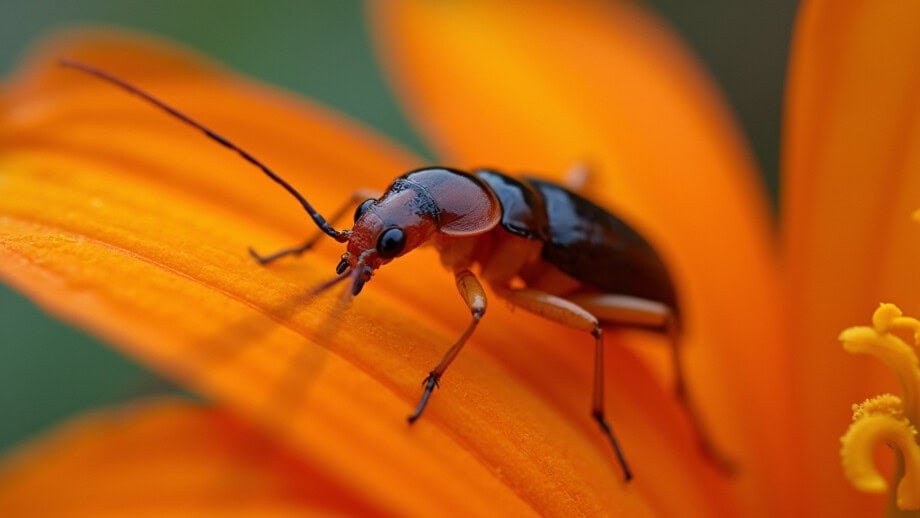What is an Earwig and How to Get Rid of Them Effectively
Learn how to identify and effectively get rid of earwigs — in gardens and potted plants — using proven, natural and organic techniques.

Primarily night feeders, the common Earwig (Forficula auricularia) is considered to be an insect pest when it feeds on soft plant shoots, such as corn silks, and eats small holes in foliage and flowers.
Sometimes ripened fruits are infested, but damage is usually tolerable. It can be particularly damaging to seedlings.
Earwigs also play a beneficial role in the garden, acting as scavengers on decaying organic matter and predators of insect larvae, snails, aphids, and other slow-moving bugs.
They are often carried great distances in produce shipments and other freight.
In this article, you’ll learn everything you need to know about earwigs, including information on earwig control and how to get rid of earwigs.
What is an Earwig?
Earwigs are members of the insect Order Dermaptera and are recognized by their slender bodies and rarely used wings.
Their name comes from an old European myth that says they crawl into people’s ears at night and tunnel into their brains while they sleep.
Although there is no scientific basis for this myth, many people find the earwig’s pincers to be rather terrifying.
There are 22 different earwig species that may be found in the United States, and they like living in large numbers. Scientists believe this is due to a pheromone scent released by these insects.
They are primarily active at night. They spend the day hiding in damp, cold areas and emerge to feed at night.
How to Identify Earwigs?
Earwigs are slender red-brown insects (3/4 inch long) with elongated, flattened bodies distinguished by a pair of sharp pincers or forceps protruding from their abdomen at the tail end, which they use for capturing prey and mating.
Males have a stout, curved pincers that are widely separated at the base, while female earwigs have more slender, and straight pincers that are closer together.
A few species have wings, although it is not a strong flier, and usually crawls in search of food.
The species that do have wings, sometimes also have two pairs of wings, with their hind wings usually folding underneath their front wings.
Earwigs will occasionally enter your house. However, their presence is accidental and they will not establish themselves or reproduce indoors.

Life Cycle of an Earwig
Adults overwinter in the soil. Females lay 20-50 cream-colored eggs in underground nests during January and February, and the newly hatched young (nymphs) first appear in April.
Nymphs are protected in the nest and do not leave until after the first molt, when they must fend for themselves.
Young earwigs develop gradually, passing through 4-5 nymphal instars before becoming adults. They are similar in appearance to adults, but lack wings and the large-sized pincers.
Most species in this country have one generation per year.
Where Do Earwigs Live?
In terms of habitat, earwigs look for environments with moisture and humidity. So outside, they can be found under piles of wet leaves, lawn debris, mulch, or in tree holes.
Typically, they spend their days hiding and their nights feeding on leaves, flowers, fruits, mold, and insects. They get access to a home through outside cracks and then proceed to go through the whole structure.
Earwigs are drawn to water sources including bathrooms, laundry rooms, and kitchens as well as crawl areas under your house. You could also encounter earwigs in your basement if it frequently becomes moist or humid.
In fact, if you suspect an earwig infestation in your house, it’s a good idea to do an inspection of the house to look for water damage as this may be what’s attracting them to your place.
It is not unheard of for them to travel to other parts of the house, such as the family rooms or bedrooms.
Also, these bugs are drawn to lights, which makes them a nuisance on patios and porches during summer evenings.
Are Earwigs Dangerous to Humans?
While earwigs may be menacing in appearance, they are harmless to humans. Besides not crawling into people’s ears at night, earwigs do not spread diseases either.
However, certain species produce a foul-smelling liquid as a self-defense mechanism. This combined with their threatening look is why many homeowners feel concerned.
In any event, garden plants are actually more at risk from earwigs than people are. They are a garden pest that feed on a range of vegetables and flowers and are normally active from late June to October.
They may cause damage to corn silk and seedlings, as well as marigolds, dahlias, butterfly bushes, and hostas by chewing irregular holes in the leaves and flower blossoms of these plants.
Larger plants are able to withstand this feeding, but a large number of earwigs can cause damage or even kill some plants, particularly seedlings and flowering plants
7 Ways to Get Rid of Earwigs
If you believe you have an earwig infestation, here’s what you can do to get rid of them:
Keep Your Home and Garden Clean
To get rid of earwigs or avoid an infestation, consider removing harborage sites on their property such as garden debris or excess mulch, or other vegetation.
Firewood piles and logs should also be moved away from the house in order to make sure there is no organic material surrounding the house.
Moreover, any trees or shrubs around the house that are contributing to creating damp, shady areas should also be trimmed back.
Seal Any Points of Entry into Your Home
Caulk made with silicone, steel wool, or a mix of the two should be used to properly seal any cracks or crevices in order to prevent earwigs from entering the house in any way.
This procedure includes caulking attic and foundation vents in addition to sealing doors and windows.
Address Any Moisture Build-Up
As a precautionary measure, check to see that the gutter and downspout systems are draining away from the house. This will assist in avoiding any moisture buildup that might potentially attract earwigs.
Furthermore, because earwigs like moist, protected places, they tend to gather in areas with heavy condensation, such as unventilated basements.
Since dirt and leaves are also attractive to earwigs, an unfinished basement floor is a perfect habitat for these pests. Using a dehumidifier and cleaning cement floors can assist in preventing earwigs from making a home your house.
Use Pest Barriers
Since earwigs seldom fly, a sticky band of Tanglefoot Pest Barrier around the trunks of trees, shrubs, and woody plants will prevent them from reaching the leaves and fruits on which they feed.
Alternatively, you can broadcast Insect Killer Granules around foundations, lawns and landscapes to eliminate or repel all kinds of troublesome pests.
Apply Diatomaceous Earth
Consider applying Diatomaceous Earth for long-lasting protection. Made up of tiny fossilized aquatic organisms, that look like broken glass under the microscope,
DE kills by scoring an insect’s outer layer as it crawls over the fine powder. Plus, it contains zero toxic poisons!
Try Baits and Traps
If you’re looking for a quick-and-simple solution, scatter TERRO Ant Bait evenly around the perimeter of your home, or wherever pests are found. Best of all, the easy-to-apply granules withstand rain and heat to kill insects quickly.
You can also consider trapping earwigs by placing rolls of damp newspaper or burlap bags in areas where they are found. Collect and dispose of pests the following day.
Use Pesticides
Least-toxic botanical insecticides should be used as a last resort. Derived from plants which have insecticidal properties, these natural pesticides have fewer harmful side effects than synthetic chemicals and break down more quickly in the environment.
Related Articles from Planet Natural:
Do Earwigs Bite & Everything You Need to Know in 2023 w Pictures













